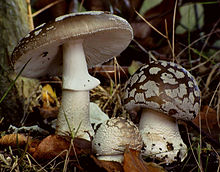Amanita excelsa, also known as the European false blushing amanita,[1] is a species of agaric fungus in the family Amanitaceae. It is found in Asia, Europe, and North America, where it grows in deciduous forests.[2]
| Amanita excelsa | |
|---|---|

| |
| Scientific classification | |
| Domain: | Eukaryota |
| Kingdom: | Fungi |
| Division: | Basidiomycota |
| Class: | Agaricomycetes |
| Order: | Agaricales |
| Family: | Amanitaceae |
| Genus: | Amanita |
| Species: | A. excelsa
|
| Binomial name | |
| Amanita excelsa | |
| Synonyms | |
| |
| Amanita excelsa | |
|---|---|
| Cap is convex | |
| Hymenium is adnexed | |
| Edibility is inedible | |
Toxicity
editAmanita excelsa var. alba is inedible.[3]
A. excelsa var. spissa is edible, but can easily be confused with the highly poisonous A. pantherina.[4]
References
edit- ^ "Standardized Common Names for Wild Species in Canada". National General Status Working Group. 2020.
- ^ Zhishu B, Zheng G, Taihui L (1993). The Macrofungus Flora of China's Guangdong Province. New York, New York: Columbia University Press. p. 268. ISBN 978-962-201-556-2.
- ^ Phillips, Roger (2010). Mushrooms and Other Fungi of North America. Buffalo, NY: Firefly Books. p. 27. ISBN 978-1-55407-651-2.
- ^ Miller Jr., Orson K.; Miller, Hope H. (2006). North American Mushrooms: A Field Guide to Edible and Inedible Fungi. Guilford, CN: FalconGuide. p. 40. ISBN 978-0-7627-3109-1.